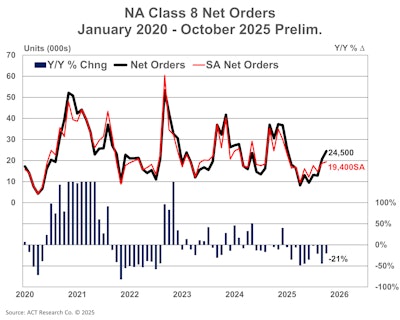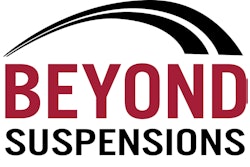Even the month of October couldn’t turn around softening medium- and heavy-duty truck orders.
ACT Research reported Tuesday combined Class 5-8 orders of 40,000 units last month, down 17% from 2024. Class 8 orders were down 21% at 24,500 units, Classes 5-7 were down 11% to 15,500 units. FTR had a similar reading of the Class 8 space, with a preliminary order total of 24,300 units, down 22% year over year.
The month was stronger than September — up 18% per FTR’s data — but ACT Research Analyst Carter Vieth says the totals were “notably weak” when taking into account October is seasonally the strongest month for orders. This is the tenth consecutive month of a year-over-year decline, FTR adds, and Class 8 orders over the last 12 months have now totaled 230,643 units.
[RELATED: What readers are saying about our increasingly ununiform downturn]
“This is the time of year when next year’s backlogs get built,” says Vieth. “Rising costs, still weak spot rates and ongoing uncertainty continue to hamper for-hire carriers and, as a result, have led to a muted order season to date. Additionally, private fleet demand has slowed after recent expansion.”

Diving deeper into the October total, FTR says last month’s total was well below the 10-year October average of 31,198 units as fleets continued to delay replacement and expansion plans amid soft freight demand, excess capacity, high interest rates, tariff volatility, uneven economic growth, regulatory uncertainty and compressed margins.
The company adds both the vocational and on-highway segments saw monthly gains, but the on-highway market accounted for the majority of the year-over-year decline, reflecting sustained fleet caution heading into 2026.
“Early indicators for the 2026 order cycle reinforce this cautious outlook. Combined net orders for September and October are 32% below year-ago levels, highlighting persistent weakness in freight fundamentals and limited carrier profitability,” says Dan Moyer, FTR senior analyst, commercial vehicles.
“The month-over-month uptick in October likely reflects targeted replacement activity rather than renewed investment. For OEMs and suppliers, visibility remains limited, and order trends are expected to stay uneven until freight volumes and rates improve. In the meantime, fleets are focusing on cost control and asset utilization over growth, delaying a meaningful rebound in equipment demand until economic and market conditions stabilize.
Moyer also notes the new tariffs on heavy-duty trucks that went into effect Saturday could raise costs on production but are less severe and more targeted than first expected. He says USMCA carve-outs, offsets and the delayed parts tariff create a measured policy that encourages reshoring and strengthens North American supply chains.
“Some production appears to be already shifting toward U.S. assembly, though expanding capacity will take time,” he says. “Overall, the framework aims to boost U.S. manufacturing and reduce reliance on Asia while leaving room for future policy adjustments.”
In the medium-duty space, Vieth adds the 15,500-unit total was limited by “economic uncertainty and rising consumer pessimism” that continue to weigh on demand.












